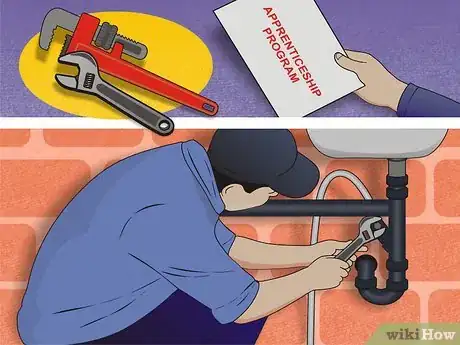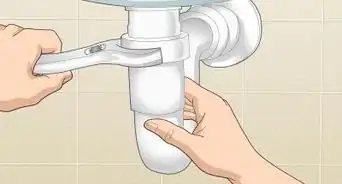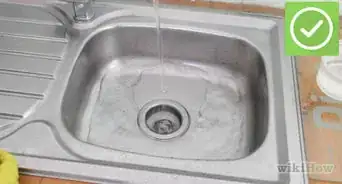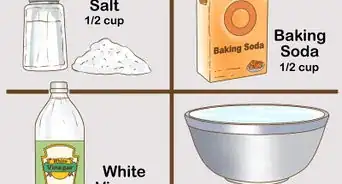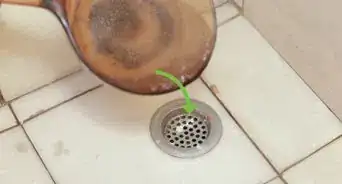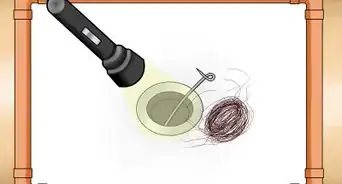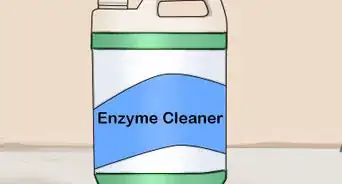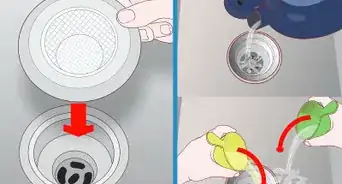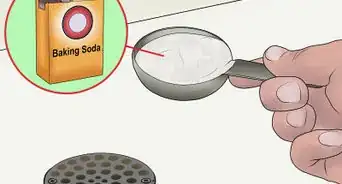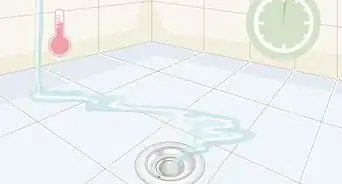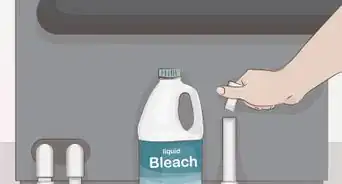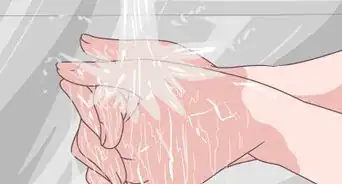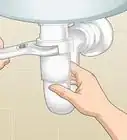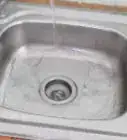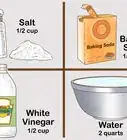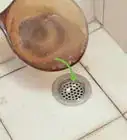This article was co-authored by James Schuelke. James Schuelke, along with his twin brother David, is the co-owner of the Twin Home Experts, a licensed plumbing, leak detection, and mold inspection company based in Los Angeles, California. James has over 32 years of home service and business plumbing experience and has expanded the Twin Home Experts to Phoenix, Arizona and the Pacific Northwest.
There are 7 references cited in this article, which can be found at the bottom of the page.
This article has been viewed 326,015 times.
If you've got a clogged sink, you don't need to reach for harsh chemicals to fix the problem. There are actually lots of natural remedies you can try using things you probably already have lying around the house. You can either use something to manually remove the clog or pour something down the drain to break the clog up. Either way, your sink will be draining in no time!
Steps
Using Manual Power
-
1Try a plunger. The plunger can unclog your sink just as easily as it can unclog your toilet. Be sure to clean the plunger before using it on the sink, though, or purchase a new plunger for use in the sink.[1]
- Cover the drain opening completely with the plunger. If you have a double sink, plug the drain you aren't plunging so you get full suction.
- Pump the plunger up and down several times to loosen the clog.
- Remove the plunger after a minute or so of work to see if water will flow down the sink. If the sink is still clogged, continue to plunge to further loosen the blockage.
-
2Use a wire coat hanger. Bend a wire coat hanger into a straight line, with the curved hook at one end. Slide the wire hook-first down your clogged drain and see if you can hook and remove or otherwise break apart any portions of the blockage.[2]
- Push the hanger down until you feel some resistance. Then, wiggle the hanger up and down and side to side to try to get it to latch onto the block.
- Once you believe you have hooked the block, pull the hanger up to clear out whatever you have caught.
- If you do not feel resistance as you push the hanger down, chances are your clog is lower and you need a specialty tool.
Advertisement -
3Snake your drain. A drain snake is a long metal cable with a coil or auger on the end that helps manually remove blockages from drains. Purchase a drain snake appropriately sized for your sink at your local hardware or home improvement store to help you clear stubborn blocks.[3]
- Feed the snake into the drain and push down until you feel some resistance from the clog. Be careful if you have older metal pipes because you could puncture the trap.
- Once you've hit the clog, turn the cable clockwise for three to four full rotations, then pull up somewhat. If you feel some resistance, you have likely hooked on the clogged matter.
- Continue to rotate the drain snake until you have pushed through the entirety of the clog and started to break it into smaller pieces.
- When you feel resistance start to lessen, pull the snake out slowly and remove what's left of the clog from the end of the auger.
- Check to make sure your drain is unclogged. If water still doesn't flow down it properly, repeat the snake process.
- Once the drain is flowing, run hot water down the pipes for 5 minutes to clean them.
Working With Natural Products
-
1Find a natural drain cleaner. Some green cleaning lines offer enzyme-based drain cleaners that may help you loosen or unclog your drain. These cleaners eat away at so-called biofilm, and thus work best on organic clogs such as hair, soap, and grease.
- Environmentally-friendly drain cleaners are often cited as working best on minor to moderate blockages, and they are unlikely to clear a major block.
-
2Use the vinegar and baking soda method. Baking soda and vinegar may help loosen clogs in your drain by dissolving and pushing gas into the clog. Try to avoid using it on metallic pipes, though, as the baking soda may corrode the pipe surface and leach metals from your water into your pipes.[4]
- Remove your drain cover and pour half a cup of baking soda directly down your drain. You may want to use a funnel to help get the product down.
- Follow the baking soda with half a cup of distilled white vinegar.
- Allow the mixture to bubble and fizz in the drain for up to 15 minutes. Once the bubbling has stopped, wash your drain out with your tap water on its hottest setting.
-
3Make a hydrogen peroxide solution. Make a solution of one cup of hydrogen peroxide for every quart of cold water. Pour this down the drain and allow to sit for 20 to 30 minutes before rinsing out using tap water on its warmest setting.[5]
- Be cautious when using hydrogen peroxide, as concentrated versions of it can cause chemical burns to the skin if not monitored properly.
- Do not use hydrogen peroxide if you previously tried a baking soda cleaner.
-
4Call a plumber. If your clog persists after you have tried multiple natural unclogging methods, you may need to contact a local plumber to assist with your clog. Let the plumber know what methods you have already tried to unclog your sink so that they can avoid using products that may cause a negative chemical reaction.
- Check local listing online or in the phonebook to see if there is a plumber near you that is environmentally-conscious.
Preventing Future Clogs Naturally
-
1Keep food out. Even if you have a garbage disposal, it is recommended that you keep food out of your drains as much as possible. Scrape food off into the trash can before rinsing, and use the disposal only for those small pieces that could not make it to the trash.[6]
- Never pour grease or oils into the drain.
- If you must use your disposal, be sure to put small amounts of food down at a time and run plenty of water while the disposal is running.
-
2Install screens. Install screens or use drain catchers in your bathroom and kitchen sinks to help prevent hair, food products, and other debris from going down the drain. Drain catches are often affordable and can generally be found at home goods and home improvement stores.[7]
- Drain screens are also advisable for shower and tub drains to help prevent hairs from causing clogs in your pipes.
-
3Run hot water. Help break apart grease and dirt by running hot water down your drain once a week or after heavy use. Turn your tap water onto it hottest setting, and allow water to flow down your pipes for two to three minutes to help loosen potential clog-causing debris.
- Periodically fill up sinks and bathtubs with hot water and drain them to keep your pipes clean.
- Do not heat tap water by boiling or microwaving it, as water that is too hot has the potential to harm your pipes.
Expert Q&A
Did you know you can get expert answers for this article?
Unlock expert answers by supporting wikiHow
-
QuestionHow do you unclog a sink without chemicals?
 James SchuelkeJames Schuelke, along with his twin brother David, is the co-owner of the Twin Home Experts, a licensed plumbing, leak detection, and mold inspection company based in Los Angeles, California. James has over 32 years of home service and business plumbing experience and has expanded the Twin Home Experts to Phoenix, Arizona and the Pacific Northwest.
James SchuelkeJames Schuelke, along with his twin brother David, is the co-owner of the Twin Home Experts, a licensed plumbing, leak detection, and mold inspection company based in Los Angeles, California. James has over 32 years of home service and business plumbing experience and has expanded the Twin Home Experts to Phoenix, Arizona and the Pacific Northwest.
Professional Plumber
Warnings
- Avoid using boiling water. It may work as a one-time fix, but it could cause warping, corrosion, or long-term damage to your pipes.⧼thumbs_response⧽
Things You'll Need
- Plunger
- Drain snake
- Baking soda
- Vinegar
- Drain catcher or screen
References
- ↑ http://www.todayshomeowner.com/video/how-to-unclog-a-bathroom-sink-drain-with-a-plunger/
- ↑ http://www.familyhandyman.com/plumbing/drain-repair/unclog-a-kitchen-sink/view-all
- ↑ https://www.doityourself.com/stry/how-to-use-a-drain-snakes
- ↑ http://www.apartmenttherapy.com/how-to-unclog-a-bathroom-sink-44368
- ↑ https://www.roth-heat.com/blog/2014/06/let-it-flow-tips-to-unclogging-a-drain/
- ↑ https://www.houselogic.com/organize-maintain/home-maintenance-tips/how-to-prevent-drain-clogs-and-blockage/
- ↑ http://homeguides.sfgate.com/keep-kitchen-sink-drainpipes-clean-41811.html
About This Article
To unclog a sink naturally, straighten a wire coat hanger, feed the curved hook into your drain, and use it to pull the clog out or break it up. You can also pour ½ a cup of baking soda down your drain followed by ½ a cup of distilled vinegar. Let the mixture bubble and fizz for 15 minutes as the chemicals react and push the clog through the drain, then run hot water down your drain. Alternatively, try mixing 1 cup of hydrogen peroxide with 1 quart of cold water and pouring it down your drain. Give it 20-30 minutes to work before you rinse it with warm water. To learn from our Handyman reviewer how to unclog your sink with a plunger or a snake, keep reading!
